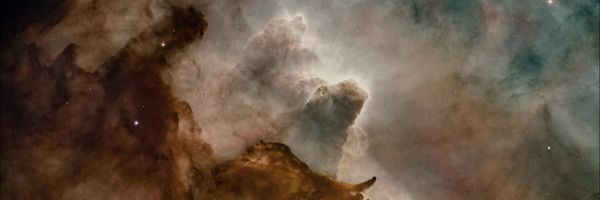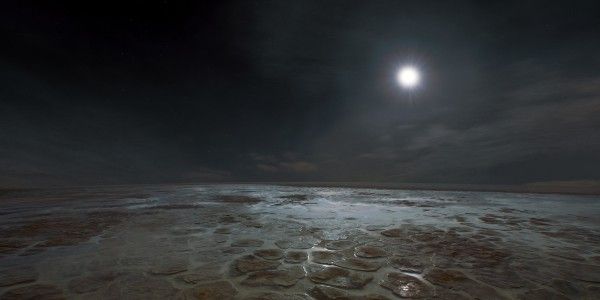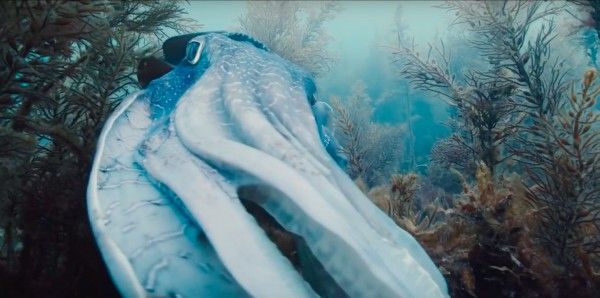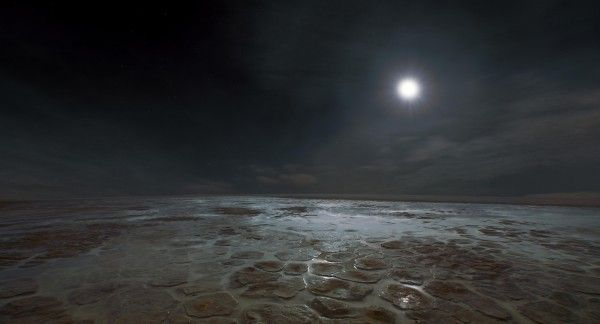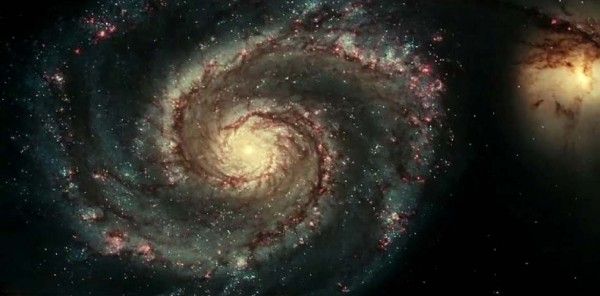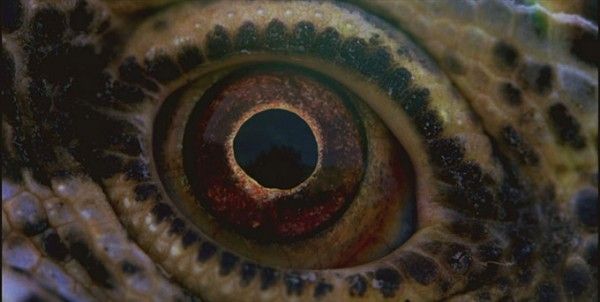There’s an image when the universe is created – of blue interconnected lines weaving together into solar systems – an image so strange and otherworldly yet still remarkably familiar. Everyone knows about the ‘big bang’ and the formation of the universe; yet in the hands of Terrence Malick and VFX Supervisor Dan Glass – the familiar textbook passages take on a enigmatic life of their own. Watching Voyage of Time can sometimes feel like staring at a jigsaw puzzle, where the pieces all fit but the final result seems, not wrong, but alien. There’s a lyrical quality to Glass’s work – planets, light and space shifting into their base visual elements: orbs drifting in a sea of darkness between intermittent streaks of white. Which is all to say - Glass and Malick have crafted the ‘Jackson Pollack’ of IMAX space films, an art film masquerading as an educational documentary.
In the following interview with VFX Supervisor Dan Glass, he discusses the unconventional VFX process, working with Terrence Malick and the evolution of the film’s effects. For the full interview, read below.
When did Terrence Malick first approach you about doing Voyage of Time?
Dan Glass: A little over ten years ago. It was a meeting where I didn't know what it was about, but it was just a dream opportunity to meet a filmmaker like Terrence. We met at a cafe and he blew my mind. As he started to describe what he wanted to do, I wondered if it could even be coalesced into a short movie. It was in parallel back then with Tree of Life. But Voyage of Time actually existed far before that. It was very much his passion to create an IMAX experience that people would be immersed and feel involved in.
Does that effect your approach to VFX – knowing it's going to be screened on IMAX?
Dan Glass: It's a lot scarier. There's nowhere to hide. Typically with Terry… how he guides the cinematography is that he wants everything in focus. He doesn't want the camera to move very much and he wants the shots to be very long. That removes any chance you have of hiding things. It all has to hold up and it has to hold up for a very long time because he wants the viewer to be able to look around and find what they want. You could potentially imagine different people getting different experiences because they’re looking at different places at different times.
You mentioned he approached you ten years ago -- is that typically how early you come onto a film for VFX?
Dan Glass: It depends on the length of the project. But for a large part of my career, I've been brought on very early in the process. In some projects, it's been before a script exists and it's about trying to come up with the visual style [of] the project. For this film, there wasn't a script per say, but we had our script laid out for us by nature itself. Terry had accumulated a vast amount of notes and he had this notebook that had all the milestones he was looking to hit. He knew we couldn't cover everything. So part of the discussion was sifting that down and figuring out what things we’re more likely to achieve successfully and which are going to be overly ambitious or risk rocking the boat. So trying to come up with a plan of attack was rather unique on this project.
What was that plan of attack? Since there's no script -- is there a treatment or a shot list you're attempting to replicate?
Dan Glass: It took me some time to wrap my head around how to attack this. Especially because from the outset Terry said he doesn't do storyboards. He doesn't do pre-viz. And so it's a little like taking all your tools away and having your hands tied behind your back and then a blindfold put on and told ‘Now go’. So the first thing I did was categorize it into broad areas. We had an astrophysical zone, we had a natural history zone, and the microbial… In those broad three realms each called out for slightly different techniques.
What were those techniques?
Dan Glass: The natural history realm was the area that had the most obvious modern day analogue equivalents. There are places you can go around the globe that can stand in for most epochs we need to represent. The microbial is interesting because it's theoretically accessible but you can't light at that scale. Actually the familiarity we have with that scale of life and organism is all shot on flat slides so it's a very planar existence. Life isn't like that. But in parallel with that, we have electron microscopy, which shows the rich detail and originality of these tiny organisms. But that only exists on inanimate or dead matter. It doesn't have any motion. So in keeping with Terry's guidance and his goal, we would find references from microscopes and slide footage that captured phagocytosis, which is the predation of cells – one cell consuming another. It's quite shocking watching cells eat themselves. You'd think you'd be removed from it but it's actually quite...
Horrifying?
Dan Glass: It is. (laughs) We'd find an example we liked and had the energy that Terry wanted and then roto-animate it so we had a representation in our computer of that motion. Then we would take the reference of these organisms and build out. For some of these we had to guess at how they would work in three dimensions. But in effect we ended up with something that was transcribed from real life and is a pretty good representation of what it would look like if you could get a camera in there on that scale.
And the astrophysical?
Dan Glass: For the astrophysical -- there's a mixture. There are things that do exist. Photography from satellites. Hubble Telescope footage. There are photographs from space probes. The SDO (Solar Dynamics Observatory) has a satellite up there shooting endless 4K footage of the sun. Just going through that footage is fantastic. You see some amazing stuff that's real. The only problem is that it's shot at intervals of several minutes so it doesn't play smoothly. We did a little bit of treatment to assist that but the footage that you see on the screen is ostensibly pretty raw.
I was going to ask what is that balance between the artistic side of the VFX while still remaining scientifically accurate?
I think that's the subtle path we were always trying to find. It was interesting even Terry would weigh one way or another depending on the circumstance. Initially he was very hard and fast on following science. But sometimes you do that and it feels very cold and clinical and didn't help convey the emotion or the amazement or wonder of these phenomena and events. You can somehow be immersed in and be aghast at what happened and how these things happened. Clearly the film doesn't try to didactically explain all the nuances behind these things but it's there if you wanted to read up on. Every shot had an incredibly rich story behind it's science, what it's trying to say, why it's there... And every single one has an interesting story behind how we made it. What the source material was and how we came up with it?
What was the range of source material used?
It's really a huge range. I gave an example of how we did some of the microscopic material. We also shot and filmed what we could with a natural history unit. We went to NASA and took images on public domain. And then we had a series of small experimental shoots, which Terry termed the Skunkworks. We did about five or six that we set over a long weekend. We would have fluid tanks where we would throw in dyes and paints. We had road flares we plunged into tubs of water. And then we would sculpt little orbs - baseball size and yoga ball size - that we would then crack and suspend in a studio space and shine a really bright light and some smoke machines at and film at a very high frame rate. You create the illusion of things way beyond the scale we were actually capturing them at. One of the things I learned in the process with Terry that was so fascinating and fulfilling is letting things evolve [naturally]. Just dropping dyes into a tank, that does what it does; but finding the thing that's interesting, that might work for a nebula or a background to some sort of cellular activity. Even with that suspended models in studio, you could sketch up a drawing; but there's nothing that replaces just getting in there and letting it be and letting it evolve.
Voyage of Time: Life’s Journey opens in IMAX on Friday

